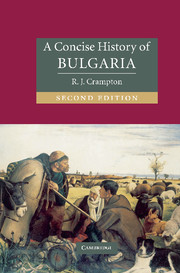Book contents
- Frontmatter
- Contents
- List of illustrations
- Preface
- Preface to the second edition
- Note on transliteration
- The Bulgarian lands: main rivers and mountains
- 1 THE BULGARIAN LANDS FROM PREHISTORY TO THE ARRIVAL OF THE BULGARIANS
- 2 MEDIAEVAL BULGARIA, 681–1393
- 3 OTTOMAN RULE IN THE BULGARIAN LANDS
- 4 THE NATIONAL REVIVAL AND THE LIBERATION
- 5 THE CONSOLIDATION OF THE BULGARIAN STATE, 1878–1896
- 6 FERDINAND'S PERSONAL RULE, 1896–1918
- 7 BULGARIA, 1918–1944
- 8 BULGARIA UNDER COMMUNIST RULE, 1944–1989
- 9 POST-COMMUNIST BULGARIA
- CONCLUSION
- Appendix 1 Bulgarian monarchs
- Appendix 2 Prime ministers of Bulgaria, 1879–2004
- Suggestions for further reading
- Index
- CAMBRIDGE CONCISE HISTORIES
2 - MEDIAEVAL BULGARIA, 681–1393
Published online by Cambridge University Press: 05 June 2012
- Frontmatter
- Contents
- List of illustrations
- Preface
- Preface to the second edition
- Note on transliteration
- The Bulgarian lands: main rivers and mountains
- 1 THE BULGARIAN LANDS FROM PREHISTORY TO THE ARRIVAL OF THE BULGARIANS
- 2 MEDIAEVAL BULGARIA, 681–1393
- 3 OTTOMAN RULE IN THE BULGARIAN LANDS
- 4 THE NATIONAL REVIVAL AND THE LIBERATION
- 5 THE CONSOLIDATION OF THE BULGARIAN STATE, 1878–1896
- 6 FERDINAND'S PERSONAL RULE, 1896–1918
- 7 BULGARIA, 1918–1944
- 8 BULGARIA UNDER COMMUNIST RULE, 1944–1989
- 9 POST-COMMUNIST BULGARIA
- CONCLUSION
- Appendix 1 Bulgarian monarchs
- Appendix 2 Prime ministers of Bulgaria, 1879–2004
- Suggestions for further reading
- Index
- CAMBRIDGE CONCISE HISTORIES
Summary
Two main problems confronted the new Bulgarian state at the end of the seventh century: the need to establish clearly defined and secure borders; and the need to weld together the two main human components of the state, the Proto-Bulgarian conquerors and the conquered Slavs. The second of these two problems was eventually to be resolved, but the first was seldom out of consideration for more than a few years; this problem was to be a persistent feature of Bulgarian states, modern as well as mediaeval.
The new state commanded a powerful position. From Pliska it could control the north–south routes through the eastern passes of the Balkan mountains and along the narrow lowland coastal strip. In the north, however, its extensive territories beyond the Danube inevitably led it into conflict with both the tribal groups milling around in the plains to the north-east, and with the succession of states which were established on the north-western borders. For the leaders of mediaeval Bulgaria, however, the most persistent and pressing problem was defining Bulgaria's relations with the great power to the south. The first mediaeval Bulgarian state was to be destroyed by Byzantium; the second was to fall to Byzantium's successor, the Ottoman empire.
BULGARIA UNDER THE KHANS, 681–852
After its foundation in 681 the new state enjoyed almost a century of growth.
- Type
- Chapter
- Information
- A Concise History of Bulgaria , pp. 9 - 28Publisher: Cambridge University PressPrint publication year: 2005



